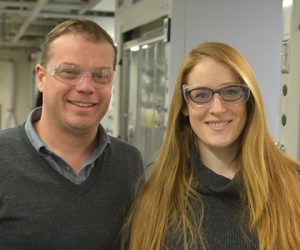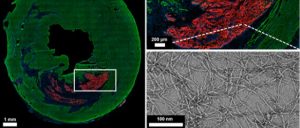Research
Exploring new ways to fix a broken heart
April 23, 2019
Scientists have designed a minimally invasive platform that turns the body’s inflammatory response into a signal to heal, rather than a means of scarring the heart following myocardial infarction.
Although tissue engineering strategies to replace or supplement degrading extracellular matrix (ECM) following heart attack are not new, researchers led by co-principal investigators Nathan Gianneschi, chemistry, biomedical engineering and materials science and engineering, and Karen Christman at the University of California, San Diego, have demonstrated a novel way to deliver a bioactivated, biodegradable, regenerative substance through a noninvasive catheter. The research was published April 15 in Nature Communications.
“We sought to create a peptide-based approach because the compounds form nanofibers that look and mechanically act very similar to native ECM; they are also biodegradable and biocompatible,” says Andrea Carlini, a postdoctoral fellow in the lab of John Rogers, materials science and engineering. Carlini was a graduate student in Gianneschi’s lab when this research was conducted and is the paper’s first author. “Most preclinical strategies have relied on direct injections into the heart, but because this is not a feasible option for humans, we sought to develop a platform that could be delivered via intracoronary or transendocardial catheter.”
Peptides are short chains of amino acids instrumental for healing. The team’s approach relies on a catheter to deliver self-assembling peptides (SAP) — and a therapeutic — to the heart following myocardial infarction.

“What we’ve created is a targeting-and-response type material. We inject a self-assembling peptide solution that seeks out a target — the damaged ECM — and is then activated by the inflammatory environment itself,” says Gianneschi, a member of Northwestern’s Simpson Querrey Institute as well as its International Institute of Nanotechnology. “The key is to have the material create a self-assembling framework, which mimics the natural scaffold that holds cells and tissues together.”
When a person has a heart attack, the matrix is stripped away and scar tissue often forms in its place, decreasing the heart’s functionality. Because of this, most heart attack survivors have some degree of heart disease, the largest killer in America.
The team’s preclinical research was conducted in rats and segmented into two proof of concept tests. The first test established that the material could be fed through a catheter without clogging and without interacting with human blood. The second determined whether the SAPs could find their way to the damaged tissue, bypassing healthy heart tissue. Researchers created a fluorescent tag for the SAPs to carry and then imaged the heart to see where the peptides eventually settled.
“In previous work with responsive nanoparticles, we produced speckled fluorescence in the infarct region, but in this case, we were able to see large continuous hydrogel assemblies throughout the tissue,” says Carlini.
Researchers now know that when they remove the florescent tag and replace it with a drug, the SAP will locate to the affected area of the heart. One hurdle is that catheter delivery in a rodent model is far more complicated — because of the animal’s much smaller body — than the same procedure in a human. This is one aspect where Christman’s lab at UC-San Diego has immense knowledge.
If the team can prove the approach to be efficacious, there is then “a fairly clear path” in terms of progressing toward a clinical trial, says Gianneschi. The process, however, would take several years.

“We started working on this chemistry in 2012, and it took immense effort to produce a modular and synthetically simple platform that would reliably gel in response to the inflammatory environment,” says Carlini. “A major breakthrough occurred when we developed sterically constrained cyclic peptides, which flow freely during delivery and then rapidly assemble into hydrogels when they come in contact with disease-associated enzymes.”
By programming in a spring-like switch, Carlini was able to unfurl these naturally circular compounds to create a flat substance with much more surface area and greater stickiness. The process creates conditions for the peptides to better self-assemble, or stack, atop one another and form the scaffold that so closely resembles the native ECM.
Having demonstrated the platform’s ability to activate in the presence of specific disease-associated enzymes, Gianneschi’s lab has also validated analogous approaches in peripheral artery disease and in metastatic cancer, each of which produce similar chemical and biological inflammatory responses.
“This research centered on building a dynamic platform and the beauty is that this delivery system can now be modified to use different chemistries or therapeutics,” he says. “We’re applying this to the heart because there’s currently nothing in the clinic that works to heal your heart and you can’t live without one, so it’s a big unmet need.”
This article is from Northwestern Research News.
The International Institute for Nanotechnology at Northwestern University is an umbrella organization that represents and unites more than $1 billion in nanotechnology research, education and supporting infrastructure.